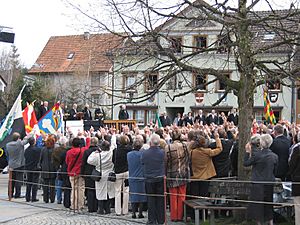Direct democracy facts for kids

A direct democracy is a type of government where people vote directly on laws and decisions. It's also called a pure democracy. Instead of choosing representatives to make choices for them, everyone gets to have a say. For example, if a new law or budget is needed, the idea goes straight to the people to vote on. This way of governing is not very common for big countries today.
Contents
Direct vs. Representative Democracy
In a direct democracy, all citizens vote on important decisions. This means that groups who want to change a law would need to convince many people, not just a few elected officials. Also, taxes could not be raised without the people's direct approval. This system aims to make sure that the many are not ruled by just a few.
Most modern countries use a different system called representative democracy. In this system, citizens elect people to represent them. These elected representatives then make laws and decisions on behalf of the people.
Who Makes the Decisions?
Direct democracy makes decisions based on what the majority of people want. This means if more than half the people vote for something, it passes.
Representative democracy was created with the idea that elected officials would look out for the interests of the majority. But they would also protect the rights of minority groups. Some thinkers, like James Madison, worried that direct democracy might not be fair to smaller groups of people.
History of Direct Democracy
Direct democracy has been used in different places throughout history.
Ancient Greece
One famous example is Classical Athens in ancient Greece. In Athens, all citizens could vote on major government decisions. This was a very early form of direct democracy.
Switzerland's Experience
Switzerland has a long history of using direct democracy. Citizens often vote on many different issues. They use special votes called referendums to decide on laws and other important matters.
Direct Democracy in the United States
The main government of the United States does not use direct democracy. However, some individual states in the U.S. do allow citizens to vote directly on certain laws through referendums. Also, some small towns in New England still use a "town meeting" system. In these meetings, citizens gather to discuss and vote on local issues.
Related pages
Images for kids
-
A Landsgemeinde, or assembly, of the canton of Glarus, on 7 May 2006, Switzerland.
See also
 In Spanish: Democracia directa para niños
In Spanish: Democracia directa para niños




